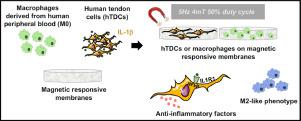Acta Biomaterialia ( IF 9.4 ) Pub Date : 2020-09-20 , DOI: 10.1016/j.actbio.2020.09.028 A Vinhas 1 , M T Rodrigues 1 , A I Gonçalves 1 , R L Reis 1 , M E Gomes 1

|
Tendinopathies represent half of all musculoskeletal injuries worldwide. Inflammatory events contribute to both tendon healing and to tendinopathy conditions but the cellular triggers leading to one or the other are unknown. In previous studies, we showed that magnetic field actuation modulates human tendon cells (hTDCs) behavior in pro-inflammatory environments, and that magnetic responsive membranes could positively influence inflammation responses in a rat ectopic model.
Herein, we propose to investigate the potential synergistic action of the magnetic responsive membranes, made of a polymer blend of starch with polycaprolactone incorporating magnetic nanoparticles (magSPCL), and the actuation of pulsed electromagnetic field (PEMF): 5 Hz, 4mT of intensity and 50% of duty cycle, in IL-1β-treated-hTDCs, and in the immunomodulatory response of macrophages.
It was found that the expression of pro-inflammatory (TNFα, IL-6, IL-8, COX-2) and ECM remodeling (MMP-1,-2,-3) markers tend to decrease in cells cultured onto magSPCL membranes under PEMF, while the expression of TIMP-1 and anti-inflammatory genes (IL-4, IL-10) increases. Also, CD16++ and CD206+ macrophages were only found on magSPCL membranes with PEMF application.
Magnetic responsive membranes show a modulatory effect on the inflammatory profile of hTDCs favoring anti-inflammatory cues which is also supported by the anti-inflammatory/repair markers expressed in macrophages. These results suggest that magnetic responsive magSPCL membranes can contribute for inflammation resolution acting on both resident cell populations and inflammatory cells, and thus significantly contribute to tendon regenerative strategies.
Statement of significance
Magnetically-assisted strategies have received great attention in recent years to remotely trigger and guide cell responses. Inflammation plays a key role in tendon healing but persistent pro-inflammatory molecules can contribute to tendon disorders, and therefore provide a therapeutic target for advanced treatments.
We have previously reported that magnetic fields modulate the response of human tendon cells (hTDCs) conditioned to pro-inflammatory environments (IL-1β-treated-hTDCs), and that magnetic responsive membranes positively influence immune responses. In the present work, we combined pulsed electromagnetic field (PEMF) and magnetic responsive membranes to guide the inflammatory profile of IL-1β-treated-hTDCs and of macrophages. The results showed that the synergistic action of PEMF and magnetic membranes supports the applicability of magnetically actuated systems to regulate inflammatory events and stimulate tendon regeneration.
中文翻译:

磁性反应材料可调节IL-1β条件化的肌腱细胞的炎症。
趋势病占全世界所有肌肉骨骼损伤的一半。炎症事件既有助于肌腱愈合,又有助于肌腱病变,但导致一种或另一种的细胞触发机制尚不清楚。在以前的研究中,我们表明,磁场驱动可调节促炎环境中的人肌腱细胞(hTDC)行为,并且磁响应膜可在大鼠异位模型中积极影响炎症反应。
本文中,我们建议研究磁响应膜的潜在协同作用,该膜由淀粉与掺有磁性纳米颗粒的聚己内酯的聚合物共混物(magSPCL)制成,以及脉冲电磁场(PEMF)的驱动:5 Hz,4mT的强度和在IL-1β处理的hTDC中,以及在巨噬细胞的免疫调节反应中占50%的占空比。
发现在magSPCL膜上培养的细胞中,促炎(TNFα,IL-6,IL-8,COX-2)和ECM重塑(MMP-1,-2,-3)的表达趋于降低。 PEMF,而TIMP-1和抗炎基因(IL-4,IL-10)的表达增加。此外,仅在使用PEMF的magSPCL膜上发现CD16 ++和CD206 +巨噬细胞。
磁响应膜对hTDC的炎症反应有调节作用,有利于消炎线索,这也受到巨噬细胞表达的消炎/修复标记的支持。这些结果表明,磁性反应性magSPCL膜可有助于作用于常驻细胞群和炎症细胞的炎症消退,从而显着有助于肌腱的再生策略。
重要声明
近年来,磁辅助策略已受到广泛关注,以远程触发和指导细胞反应。炎症在肌腱愈合中起关键作用,但持续的促炎分子可导致肌腱疾病,因此为晚期治疗提供了治疗靶点。
我们以前曾报道过,磁场调节适应于促炎环境(IL-1β处理的hTDC)的人肌腱细胞(hTDC)的反应,而磁响应膜对免疫反应产生积极影响。在目前的工作中,我们结合了脉冲电磁场(PEMF)和磁响应膜来指导IL-1β处理的hTDC和巨噬细胞的炎症反应。结果表明,PEMF和磁性膜的协同作用支持了磁致动系统调节炎症事件和刺激肌腱再生的适用性。











































 京公网安备 11010802027423号
京公网安备 11010802027423号